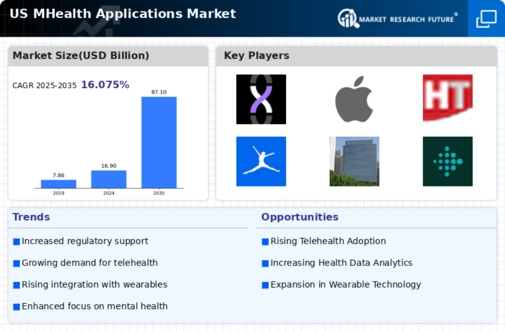Increased Health Awareness Among Consumers
There is a growing trend of health awareness among consumers, which is positively influencing the mhealth applications market. As individuals become more conscious of their health and wellness, they are actively seeking tools that can assist them in maintaining a healthy lifestyle. Surveys indicate that nearly 70% of consumers in the US are interested in using mobile health applications to monitor their fitness and nutrition. This heightened awareness is prompting developers to create more user-friendly and accessible applications, catering to a diverse audience. As a result, the mhealth applications market is poised for growth as it aligns with the evolving preferences of health-conscious consumers.
Technological Advancements in Mobile Health
Technological advancements are significantly shaping the mhealth applications market. Innovations in mobile technology, such as improved smartphone capabilities and the proliferation of high-speed internet, facilitate the development of sophisticated health applications. Features like real-time data analytics, artificial intelligence, and machine learning are becoming increasingly integrated into these applications, enhancing their functionality and user experience. For instance, the incorporation of AI-driven chatbots for patient interaction is gaining traction. This trend suggests that as technology continues to evolve, the mhealth applications market will likely see a rise in user engagement and satisfaction, ultimately driving market growth.
Rising Demand for Chronic Disease Management
The mhealth applications market is experiencing a notable surge in demand for chronic disease management solutions. As the prevalence of chronic conditions such as diabetes and hypertension continues to rise, patients increasingly seek mobile health applications that facilitate self-management and monitoring. According to recent data, approximately 60% of adults in the US live with at least one chronic disease, which underscores the necessity for effective management tools. These applications empower users to track their health metrics, receive reminders for medication, and access educational resources. Consequently, the mhealth applications market is likely to expand as healthcare providers recognize the potential of these tools to enhance patient outcomes and reduce healthcare costs.
Growing Investment in Digital Health Startups
The mhealth applications market is witnessing a surge in investment directed towards digital health startups. Venture capital funding for health technology companies has increased significantly, with investments reaching over $10 billion in recent years. This influx of capital is fostering innovation and enabling startups to develop cutting-edge applications that address various health challenges. Investors are particularly interested in solutions that enhance patient engagement and improve health outcomes. This trend indicates that the mhealth applications market is likely to benefit from a continuous stream of innovative products and services, further driving its growth.
Supportive Government Initiatives and Policies
Supportive government initiatives and policies are playing a crucial role in the expansion of the mhealth applications market. Various federal and state programs are being implemented to promote the adoption of digital health technologies. For instance, the Centers for Medicare & Medicaid Services (CMS) has introduced reimbursement models that incentivize the use of mhealth applications for patient care. Such policies not only encourage healthcare providers to integrate these technologies but also enhance accessibility for patients. This supportive regulatory environment suggests that the mhealth applications market will continue to thrive as stakeholders recognize the benefits of digital health solutions.

























Leave a Comment